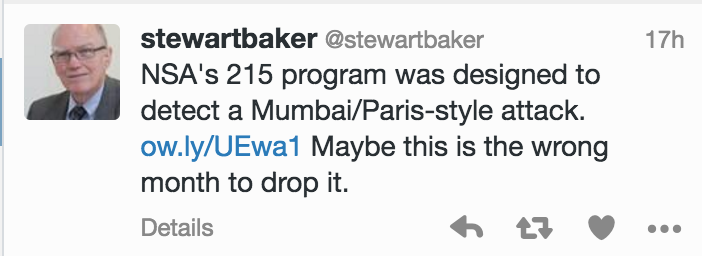Tuesday Morning: Toivo’s Tango
Did you know the tango evolved into a Finnish subgenre? Me neither, and I’m part Finn on my mother’s side of the family. Both my grandmother and great-grandmother spoke Finn at home after their immigration to the U.S., but apparently never passed the language or Finnish music on to my mother and her siblings. The Finnish tango became so popular a festival — the Tangomarkkinat — was established to celebrate it.
The tango makes its way back again, nearly 9000 miles from its origin to Finland, in this music video. The performer featured here is a very popular Argentine tango singer, Martin Alvarado, singing in Spanish a popular Finnish tango, Liljankukka, written by Toivo Kärki. If you search for the same song and songwriter in YouTube, you’ll trip across even more Finnish tango.
Let’s dance…
Police raid in Belgium today
There were more arrests in Belgium today in connection to Paris attack in November. Not many details yet in the outlets I follow, suggesting information is close to the vest; there was more information very early, which has now moved off feeds, also suggesting tight control of related news. A raid in the southern Brussels suburb of Uccle resulted in the arrest of three persons now being questioned. This raid follows the arrest last Friday of Mohamed Abrini, who has now admitted he is the man seen in security camera video as the ‘man in the hat’ observed just before the bombing of the Brussels’ airport. Thus far, intelligence gathered from suspects and locations indicates a second attack had been planned, attacking the Euro 2016 football championship. Worth noting the media has now been reporting only the given name and a family name first initial for some of those arrested recently.
Up All Night growing, annoying some Parisians
This Occupy movement subset called ‘Up All Night’ or ‘Night Rising’ (Nuit debout) has been rallying during evening hours, protesting austerity-driven labor reforms, France’s continued state of emergency after November’s terrorist attacks, and more. The number of protesters has grown over the last 12 days they have taken to the streets, driven in part by the Panama Papers leak. The crowd has annoyed those navigating the area around the Place de la Republique where the Nuit debout gather. (More here on video.)
Upset over Burr-Feinstein draft bill on encryption continues
The Consumer Technology Association (CTA) issued a statement last night conveying their displeasure with this proposed bill which would mandate compliance with law enforcement access to encrypted digital content. The CTA’s 2200 members include Apple, Google, Microsoft, and any consumer electronic technology manufacturer featured at the annual Consumer Electronics Show each year. This formal statement follows a wave of negative feedback from technology and privacy experts since the draft bill was revealed late last week.
Odds and ends
- Cellebrite makes the news again, this time for a ‘textalyzer’ (Ars Technica) — Huh. What a coincidence that an Israeli company attributed with the cracking of the San Bernardino shooter’s iPhone 5c is now commercializing a device for law enforcement to use on drivers’ cellphones. Do read this piece.
- DARPA still fighting for relevance with its Squad X initiative (Reuters) — Not a single mention of exoskeletons, but enough digital technology to make soldiers glow in the dark on the battlefield.
- Microsoft’s director of research calls some of us chickenshit because AI is peachy, really (The Guardian) — Uh-huh. This, from the same company that released that racist, sexist POS AI bot Tay not once but twice. And we should all just trust this stuff in our automobiles and in the military. Ri-ight.
- Farmers watching more than commodities market and the weather (Fortune) — Chinese IP rustlers are sneaking commercially-developed plant materials back to PRC. Hope the Chinese realize just how likely American farmers are to use firearms against trespassers.
- CDC’s deputy director on Zika: “Everything we look at with this virus seems to be a bit scarier than we initially thought” (Reuters) — I swear multiple news outlets including WaPo have changed the heds on stories which originally quoted this statement. Zika’s observed destruction of brain cells during research is really distressing; so is Zika’s link to Guillain-Barre syndrome in addition to birth defects including microcephaly. In spite of the genuine and deep concern at CDC over this virus’ potential impact on the U.S., the CDC is forced to dig in sofa cushions for loose change to research and fight this infectious agent. Absolutely ridiculous, like we learned nothing from our experience here with West Nile Virus.
That’s it, off to mix up my tango with a whiskey foxtrot. See you tomorrow morning!

